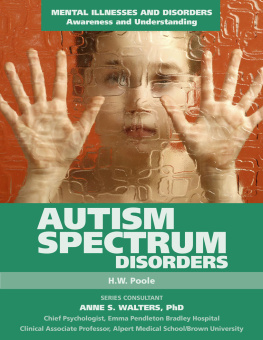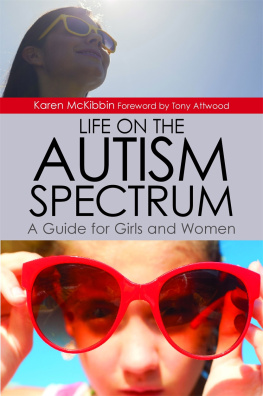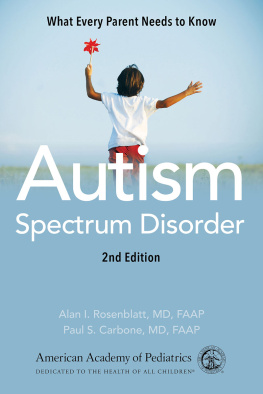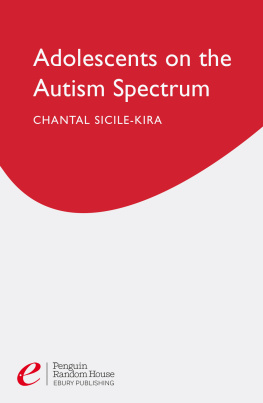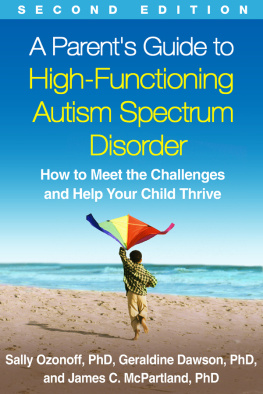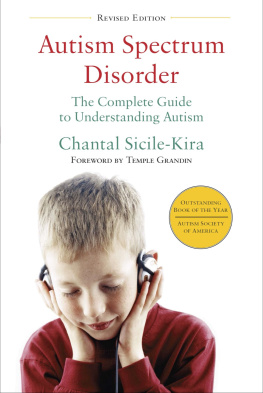
Prosody Intervention
for High-Functioning
Adolescents and
Adults with Autism
Spectrum Disorder
Enhancing communication
and social engagement through
voice, rhythm, and pitch
_____
Michelle Dunn and Larry Harris
_____
Illustrations by Julia Dunn
_____

Jessica Kingsley Publishers
London and Philadelphia
Contents
Introduction
Prosody is the music of speech. It is the nonverbal aspect of oral communication, which occurs through the modulation of loudness, pitch, and rhythm (including duration, pausing, and tempo). It is necessary for conveying emotion and meaning, through stress on what is important, and through resolution of ambiguity in words and sentences (Diehl et al. 2008). It provides signals in discourse which regulate conversational interaction.
Prosody deficits are well documented in people with Autism Spectrum Disorder (ASD) (Provonost, Wakstein, and Wakstein 1966; Fay and Schuler 1980; Tager-Flusberg 1981; Scott 1985; Baltaxe and Simmons 1992; Ghaziuddin and Gerstein 1996; Shriberg et al. 2001; Tager-Flusberg 2001; McPartland and Klin 2006; Pepp et al. 2007). One in 68 individuals is diagnosed with an ASD (CDC 2014) based on core deficits in social communication and rigid repetitive behaviors (American Psychiatric Association 2013). It is estimated that between 47 percent and 57 percent of high-functioning adolescents with ASD have impaired prosody (Simmons and Baltaxe 1975; Shriberg et al. 2001). Deficits in prosody tend to persist even when other aspects of communication improve (Kanner 1971; McCann et al. 2007). Prosodic deficits in individuals with ASD are thought to be among the greatest detriments to integration into society, because they profoundly affect social communication (Mesibov 1992) and produce a first impression of oddness (Van Bourgondien and Woods 1992). Specifically, these deficits can prohibit individuals from developing social relationships or from gaining employment. These deficits are also among the most resistant to intervention.
There are many aspects to prosody. The four main categories are: timbre , volume , pitch , and rhythm . Timbre involves both voice quality and resonance. Voice quality is influenced by the manipulation (voluntary or involuntary) of the larynx and can be influenced by the positioning of the surrounding muscle tissue. Resonance is a quality of sound produced by the shape of the vocal tract (e.g., nasal or oral). Volume or loudness is the intensity of the sound, measured in decibels. The pitch of an utterance is its highness or lowness, measured by frequency. Intonation is pitch contour, used to express meaning (e.g., statement, question). Rhythm involves rate, stress, and phrasing. The flow and fluency of spoken utterances are directly affected by the rate or speed of those utterances. Stress involves emphasis on syllables and words for the purpose of conveying a specific meaning and emotion. Stress in language is produced by increasing the volume, pitch, or length of a sound. Phrasing describes the way speech flows, pauses, and ends, and it helps to direct the listeners focus and comprehension. Prosody not only involves the voice but the body as well. Expressive and receptive nonverbal prosody include: gesturing, body posture, eye movement, and facial expression (in both static and transient situations). Prosody communicates important aspects of meaning and intention, including word form, sentence type, and emotion. Through appropriate timbre, volume, pitch, rhythm, and gesture, concepts are communicated effectively and efficiently.
Understanding and addressing the prosody deficits in high-functioning individuals with ASD is necessary in helping these intelligent individuals so that they may have productive adult lives. Atypical prosody can compromise meaning, distract the listener, and cause the listener to become disconnected from the speaker, thus producing further social isolation for the speaker.
Prosody deficits in ASD
What are the specific deficits in prosody observed in high-functioning adolescents and young adults with ASD? How powerfully do they predict social and communication impairment? What efforts have been made to remediate them?
A number of investigators identify specific prosody deficits in individuals with ASD. Wiklund (2016) observed that prosodic features, such as large pitch excursions, stretched syllables, dysfluent rhythm, low volume, and creaky voice quality, in young adolescents with ASD, disrupt comprehension and reciprocal communication. In a group of high-functioning (average IQ) young adults with ASD, Shriberg et al. (2001) assessed a range of aspects of prosody including: phrasing, rate, stress, loudness, pitch, voice quality, and resonance. They found significant impairment in phrasing, stress, and resonance. The subjects in their study demonstrated hyper-nasal timbre, connected speech that was dysfluent, and a failure to appropriately stress the focus words in sentences. Individuals with ASD have difficulty imitating stress even on nonsense syllables (Paul et al. 2008) and prosodic pattern (Diehl and Paul 2012), suggesting issues with perception and/or motoric production of stress.
Paul, Augustyn et al. (2005) examined perception and production of grammatical and pragmatic/affective stress, intonation, and phrasing in people with ASD, ages 14 to 21. Grammatical stress conveys syntactic information in sentences (Warren 1996) and is the term used to describe how emphasis on one syllable or another, within a particular word, determines whether that word is a noun or a verb (e.g., re cord versus re cord ). The emphasis placed on a particular word within a sentence is called pragmatic stress . Pragmatic stress placed on a different word in the exact same sentence changes the intent of the sentence (e.g., I want chocolate ice cream versus I want chocolate ice cream ) (Bates and MacWhinney 1979). Grammatical intonation signifies whether a sentence is a statement or a question through pitch inflection. Pragmatic intonation is the term used to describe the change in pitch when speaking to different listeners (e.g., speaking to an adult versus a child). Grammatical phrasing involves pauses in sentences, which determine meaning (e.g., Ellen, the dentist, is here versus Ellen, the dentist is here) (Gerken and McGregor 1998). Pragmatic phrasing involves a change in rate (faster) within a sentence to express affect (e.g., excitement, anxiety). Unfortunately, Paul, Augustyn et al. s (2005) findings revealed ceiling effects for some of their measures of prosody, indicating that the tests were too easy for the subjects. However, these investigators did find abnormalities in perception and production of grammatical stress and perception and production of pragmatic/affective stress. These findings are inconsistent with those of Paul, Shriberg et al. (2005) in that the two studies were discrepant with regard to whether phrasing is impaired in individuals with ASD.
What are possible reasons for the discrepancies? In the prosody literature to date there are many reasons for discrepancies in the findings. These are methodological differences, including age of the sample studied, limited sample size, lack of normative data and other contrast groups, poor definition of the various aspects of prosody, and much of the data being subjective rather than objective (Paul, Augustyn et al. 2005). In the studies by Paul, Shriberg et al. (2005) and Paul, Augustyn et al. (2005), subjects included similar groups of individuals with ASD, who had normal range verbal and nonverbal IQ scores, similar language scores, and similar Vineland Communication and Socialization scores. However, individuals in the Paul, Shriberg et al. (2005) study were older, with an average age of 21.15, whereas subjects in Paul, Augustyn et al. (2005) had an average age of 16.8. While this is one possible reason for the discrepancy in findings regarding phrasing/fluency between the studies, a more likely explanation is the difference in the way prosody was assessed. In Paul, Shriberg et al. (2005), prosody was assessed with the Prosody Voice Screening Profile (PVSP) (Shriberg, Kwiatkowski, and Rasmussen 1990), in which a spontaneous, conversational language sample is collected and scored. In the Paul, Augustyn et al. (2005) study, subjects were seen individually for a direct test of prosody. Subjects were trained, where the examiner gave a typical item and told the subject the correct response and then allowed the subject to try a test item. If the subject responded incorrectly, the examiner corrected the subject and explained why the response was incorrect. There was reinforcement by praise for correct answers. So in comparing these studies it is not surprising that the individuals with ASD demonstrated more deficits in spontaneous conversation than on direct testing where correct responses are modeled. Spontaneous dialogue is more difficult for the individual with ASD, due to language formulation issues. When using the PVSP to assess prosody, conversation was never corrected or prompted. Therefore, the PVSP likely gave a truer (more ecologically valid) assessment of prosody dysfunction.
Next page

